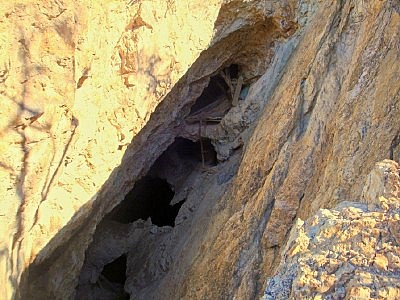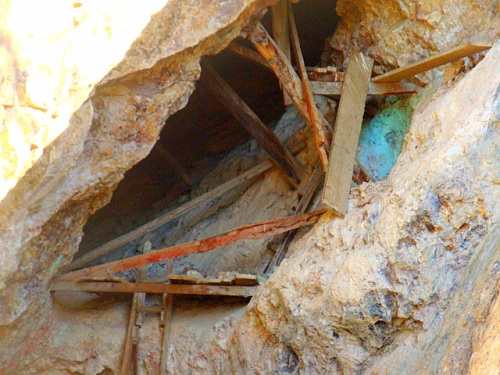NOTE TO READERS: In keeping with our philosophy of lifelong learning, we are now on Twitter as @cachemaniacs. If you’re interested, there’s a Twitter follow button over on the sidebar or you can just click this link.
This is the long abandoned Montana Mine in Ruby, Arizona, a ghost town about 75 miles south of Tucson and five miles from the Mexican border. Starting in 1877, a succession of owners spent 40 years carving out a meager existence mining gold and hoping to strike it rich. None of them did and by the early 1920’s, Ruby and its mine were on the verge of becoming a footnote in Arizona history. Then in 1926, a mining corporation from Joplin, MO came in and converted it into a successful lead mine. During the Great Depression, Ruby was a full fledged boomtown. At its peak in the 1930’s, it covered 400 acres and had 1,200 people, 300 of whom were miners. Mining went on 24×7 with an average wage of $3 a day. When the mine closed in 1940, the town died.
The mine was dug into a ridgeline called Eggshell Hill overlooking Ruby. There was a single shaft that went down almost 1,000 feet and nine levels of subterranean tunnels, along with secondary shafts in many directions. There were so many that the entire hill became unstable to the point where several decades ago, a portion of the southeast end of it collapsed. This exposed a cross-section of the mine – just like someone sliced off the end of the hill so you could see inside.
I call it The Bat Cave. From May to September, it’s the home of an estimated 200,000 Mexican free-tailed bats. They swarm at dusk and dawn, blackening the sky above Ruby for almost five minutes. Biologists estimate they eat several tons of bugs every night.

You can clearly see the honeycomb of shafts and levels of the Montana Mine. They keep going down into the darkness but the edge was too unstable to risk a closer look. I was already past the warning sign. With binoculars and proper light, you can see timbers, hopper cars, wooden ladders and railroad track. This is where the Mexican freetail bats swarm in and out of from May to September.
I was never much of a photographer but have become increasingly interested in it as we continue our adventures in retirement. As such, I’ve always got a camera with me primed and ready. You never know when you’ll run into the mythical “Place That Nobody Knows About and Few Have Seen.” This one definitely qualifies.

Here’s a closeup of the top of the cave in. You get a much better view of the remnants in the shafts. With binoculars and some favorable light, you can see even more.
Almost all of my pictures are done on the move and on the fly, with little planning and setup time. You come upon some great shots but grabbing them can be challenging. Neither of these pictures really do the area justice. It’s a massive cave in and it goes down into the blackness almost 1,000 feet. There’s a single strand of rusty barbed wire fence around the top and a warning sign – both of which I ignored. Anything for the shot.
I took both pictures with a Nikon D3100 on automatic settings, an 18-270mm lens and a circular polarizer. It was about 4:00 PM in January and the light/shadows were not helpful. In the original photos, the mine area is pitch black and the sunny slopes are almost whiteouts. I edited them in Picasa to bring out as much detail as I could. By altering the light and saturating the color, they came out pretty well. If we go back, I’ll try a series of shots for an HDR photo.
Ruby is a fascinating place. If you like ghost towns, you’ll love Ruby. You can read all about it on our website.
Here’s another recent blog posting about Ruby that you might like.
To the batcave … Boris and Natasha
Leave a comment